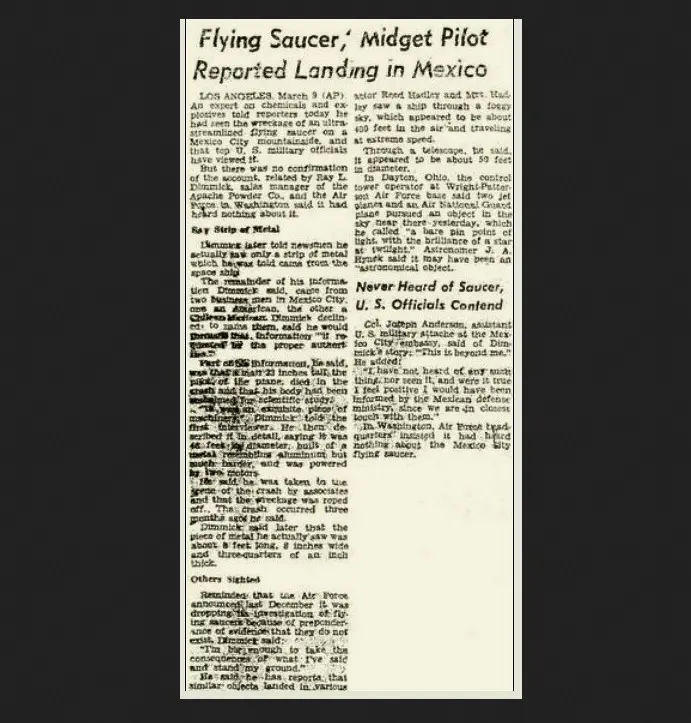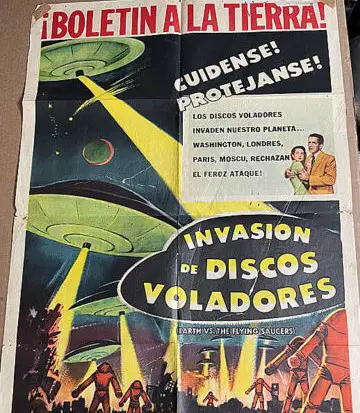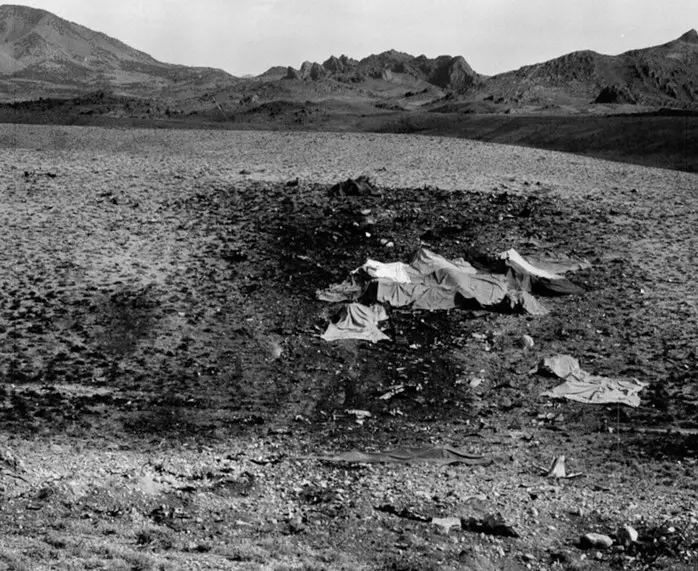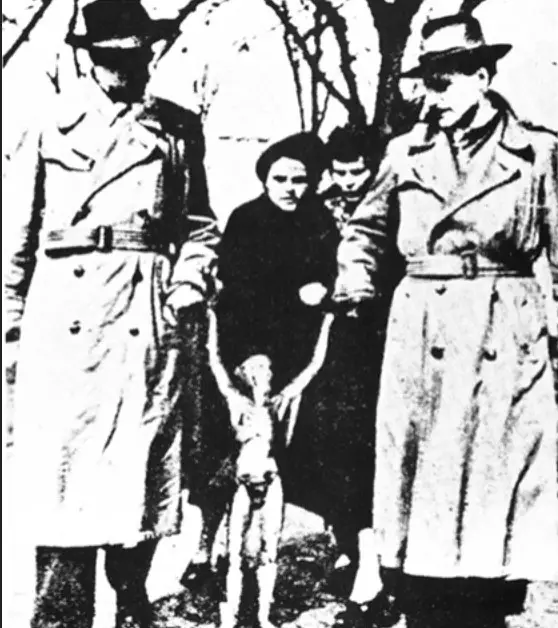Podcast: Play in new window | Download
Subscribe: Apple Podcasts | RSS
 In the March 10, 1950, edition of the Washington Herald a very curious article appeared many pages into the newspaper. The headline read: “Flying Saucer, Midget Pilot Reported Landing in Mexico.” The article barely took up two columns and told the curious tale of an American man named Ray L. Dimmick and his eyewitness account of an alleged UFO crash in the mountains south of Mexico City sometime in December of 1949. The article went on to say that Dimmick also handled a piece of the wreckage of the craft, a strip of durable aluminum measuring 6 feet long, 8 inches wide and three quarters of an inch thick. This brief newspaper piece concluded with an official statement from Colonel Joseph Anderson, assistant US military attaché stationed at the American Embassy in Mexico City. He said of Dimmick’s report: “It’s beyond me. I have not heard of any such thing nor seen it and were it true I feel positive I would have been informed by the Mexican Defense Ministry since we are in closest touch with them.” The article was sent across the Associated Press wires and several newspapers across the United States picked up the story. Some Mexican newspapers at the time also reported on the incident. These included, Novedades, Excelsior, La Prensa, El Nacional, El Universal, Ultimas Noticias and El Mercurio, to name a few. The story resurfaced in the pulp UFO press in the 1970s on both sides of the border. During the ‘70s more investigations were conducted on this incident. Some new pieces of information – and possibly some embellishments – were added to the story. This early saucer crash picked up a little traction in the early 2000s – with the advent of the blog – with now-defunct websites giving the story some play. All this telling and retelling of the story over many decades makes the job of untangling it all the more difficult.
In the March 10, 1950, edition of the Washington Herald a very curious article appeared many pages into the newspaper. The headline read: “Flying Saucer, Midget Pilot Reported Landing in Mexico.” The article barely took up two columns and told the curious tale of an American man named Ray L. Dimmick and his eyewitness account of an alleged UFO crash in the mountains south of Mexico City sometime in December of 1949. The article went on to say that Dimmick also handled a piece of the wreckage of the craft, a strip of durable aluminum measuring 6 feet long, 8 inches wide and three quarters of an inch thick. This brief newspaper piece concluded with an official statement from Colonel Joseph Anderson, assistant US military attaché stationed at the American Embassy in Mexico City. He said of Dimmick’s report: “It’s beyond me. I have not heard of any such thing nor seen it and were it true I feel positive I would have been informed by the Mexican Defense Ministry since we are in closest touch with them.” The article was sent across the Associated Press wires and several newspapers across the United States picked up the story. Some Mexican newspapers at the time also reported on the incident. These included, Novedades, Excelsior, La Prensa, El Nacional, El Universal, Ultimas Noticias and El Mercurio, to name a few. The story resurfaced in the pulp UFO press in the 1970s on both sides of the border. During the ‘70s more investigations were conducted on this incident. Some new pieces of information – and possibly some embellishments – were added to the story. This early saucer crash picked up a little traction in the early 2000s – with the advent of the blog – with now-defunct websites giving the story some play. All this telling and retelling of the story over many decades makes the job of untangling it all the more difficult.
First, let’s start with some context. This event happened in December of 1949, which was over 2 years after the famous “Roswell Incident” during which a flying saucer supposedly crashed in the deserts of New Mexico and its wreckage and occupants were allegedly whisked away by the US military. This Mexico City crash was reported just a few months after the famous article in True magazine in which Major Donald Keyhoe, a US Marine aviator, first theorized publicly that the flying saucer phenomenon was extraterrestrial in origin. Later in 1950, Keyhoe would author a book  titled, The Flying Saucers are Real. The Mexico City incident happened more than two years before the famous UFO sightings over Washington DC in July of 1952. The 1952 US capital UFO flap is not to be confused with the 1956 movie, “Earth vs. the Flying Saucers” which depicted memorable scenes of UFOs over Washington. So, this 1949 alleged saucer crash outside of Mexico City is one of the earliest of its kind ever reported. To add a little bit more to the context, during this time, the new phenomenon of “flying saucers” was generating a lot of interest in the United States, and people across the Rio Grande began searching for the famous objects that had been seen in North American skies. When Mexicans saw weather balloons – or Venus – above them, they thought, without hesitation, that they were seeing the famous flying saucers. Some of these incidents made it to local newspapers throughout Mexico. It is strange, though, that the first newspaper to pick up on the alleged saucer crash outside of Mexico City in late 1949 was the Denver Post and most of the details about this event have come to us from non-Mexicans.
titled, The Flying Saucers are Real. The Mexico City incident happened more than two years before the famous UFO sightings over Washington DC in July of 1952. The 1952 US capital UFO flap is not to be confused with the 1956 movie, “Earth vs. the Flying Saucers” which depicted memorable scenes of UFOs over Washington. So, this 1949 alleged saucer crash outside of Mexico City is one of the earliest of its kind ever reported. To add a little bit more to the context, during this time, the new phenomenon of “flying saucers” was generating a lot of interest in the United States, and people across the Rio Grande began searching for the famous objects that had been seen in North American skies. When Mexicans saw weather balloons – or Venus – above them, they thought, without hesitation, that they were seeing the famous flying saucers. Some of these incidents made it to local newspapers throughout Mexico. It is strange, though, that the first newspaper to pick up on the alleged saucer crash outside of Mexico City in late 1949 was the Denver Post and most of the details about this event have come to us from non-Mexicans.
So, what are the details of this 1949 Mexico crash? The sales manager of an American corporation called the Apache Powder Company, a man named Ray L. Dimmick, was the principal source of information about this incident. Dimmick was described in many articles as being an “amateur golfer” and was in Mexico City on a business trip when the event occurred. Among the remains of the metallic wreckage found 30 miles south of Mexico City was the body of a humanoid, about 64 centimeters tall, which is barely more than two feet. The humanoid had a large head and small body. The supposed alien had sustained severe injuries and died from the impact. The saucer was about 45 feet in diameter and was powered by two motors. It was constructed of a very durable aluminum. Mexican military authorities cordoned off the area and recovered the remains. Everything found at the crash site was taken to a nearby Mexican military base. Researchers theorize that the base was Campo Militar Numero Uno, which was outside of Mexico City in 1949 and is now considered part of the Mexico City metropolitan area. The day after the first article appeared in the US papers, Dimmick retracted part of his story. He admitted that he hadn’t actually seen the saucer. He claimed that the story had been told to him by two of his associates in Mexico City. One of the men was said to be American and the other was either Chilean or Ecuadoran. Dimmick said he would only reveal their names if directed to by the authorities. The only thing Dimmick said he had seen was the metal strip mentioned earlier. Dimmick claimed that some members of the US military had seen the object, “but for military security reasons the whole thing has been kept secret.” In Washington, D.C., the highest-ranking military official in the US Air Force claimed to know nothing about the matter and declared, “If any American military person saw the object, he will have to make a report.” No report was forthcoming. Later Dimmick stated: “I think the government has taken a clear position, but if you don’t want to discuss this issue for security reasons, why do you say it’s not true?”
 Years later, Raymond E. Fowler, in an April 1976 article in Official UFO Magazine, said he had located a former employee of United States Naval Intelligence, who claimed to have been sent to Mexico to investigate Dimmick’s story. According to Fowler, his anonymous witness assured him that he had personally seen the remains of the saucer and had even been present when the Mexican military loaded the remains of the humanoid onto a truck. According to this magazine article, Brigadier General Antonio Cárdenas Rodríguez, Director of Military Aeronautics, the predecessor of the Mexican Air Force, denied having knowledge of the case and stated that, in accordance with the “Good Neighbor Policy,” he would report on any and all observations from Mexican pilots regarding UFOs. As every good ufologist knows, that is one of the typical things said in the UFO cover up. According to the anonymous magazine source, the Mexican Air Force didn’t hand over the crashed metal craft to the Americans. Rather, it supposedly kept the saucer and through reverse engineering has developed supersonic planes invisible to radar. In this 1976 article, Dr. Gerard P. Kuiper, professor of astronomy at the University of Chicago, commented, jokingly, that although the pilot who fell to earth in Mexico was a little man, it was likely that the pilots of the spaceships could be small insects or intelligent plants, since in his opinion, those were the only things that could live on Mars.
Years later, Raymond E. Fowler, in an April 1976 article in Official UFO Magazine, said he had located a former employee of United States Naval Intelligence, who claimed to have been sent to Mexico to investigate Dimmick’s story. According to Fowler, his anonymous witness assured him that he had personally seen the remains of the saucer and had even been present when the Mexican military loaded the remains of the humanoid onto a truck. According to this magazine article, Brigadier General Antonio Cárdenas Rodríguez, Director of Military Aeronautics, the predecessor of the Mexican Air Force, denied having knowledge of the case and stated that, in accordance with the “Good Neighbor Policy,” he would report on any and all observations from Mexican pilots regarding UFOs. As every good ufologist knows, that is one of the typical things said in the UFO cover up. According to the anonymous magazine source, the Mexican Air Force didn’t hand over the crashed metal craft to the Americans. Rather, it supposedly kept the saucer and through reverse engineering has developed supersonic planes invisible to radar. In this 1976 article, Dr. Gerard P. Kuiper, professor of astronomy at the University of Chicago, commented, jokingly, that although the pilot who fell to earth in Mexico was a little man, it was likely that the pilots of the spaceships could be small insects or intelligent plants, since in his opinion, those were the only things that could live on Mars.
In Mexico, from late 1949 to the first half of 1950, it seems like the country had been experiencing its first wave of flying saucers, and the news reached the United States and was covered in the press intermittently. On March 2, 1950, two astronomy students, Luis Munch and Lauro Herrera, playing with the telescope camera of the Tonantzintla National Astronomical Observatory in Puebla, left the shutter open. When the plates were developed, a streak of light appeared, like the trace of a race car. The photograph was published in the Excelsior newspaper, and the report of the event and the photo as well, were published in True Magazine north of the border. Dr. Luis Enrique Erro explained that the object was a 23-kilometre-diameter meteorite that passed between the orbits of the Moon and the Earth. Others, once again, dismissed it as the planet Venus. The lack of more data prevents researchers from exploring other explanations, but many at the time stated openly that, undoubtedly, it was an extraterrestrial spacecraft. To a Los Angeles Times writer, the object looked like a stage lamp from a movie set. On March 9, which is the same day that Dimmick’s saucer crash reached US newspapers, the newspaper El Nacional, the official information organ of the Mexican government, reported that a Mexican scientist claimed that the astronomy students had captured the image of a flying saucer and it had come from Mars. That same week, the Excelsior newspaper published a series of articles about what it had called “Flying Saucer Madness” that had seized the minds of Mexicans at the time. On March 14, hundreds of people said they had seen four saucers fly over Mexico City and dozens of others saw a UFO hovering over the city of Monterrey. Two Americans from Colorado, who were in Monterrey on a business trip, said they were also able to observe the saucer and this news was reported in several American newspapers.
 Three months later, at the end of June 1950, another piece of news emerged, described by American Air Force officials as the most insane of all the stories about UFOs. The small weekly newspaper Talk of the Times published two photographs as proof of the existence of flying saucers. They were said to have been taken in Arizona after the craft had flown out of Mexico and across the border into US airspace. The first photo showed a huge, highly tilted flying disk, identical to the one Dimmick described in the Mexico City saucer crash. The photo caption read: “Hit by rocket bombs, the disk exploded producing a shower of sparks and around 20 silver capsules fell to the ground from within.” The other photograph was the most interesting and impressive. It showed a small being about three feet in height and wearing bright clothing. The “little Martian” was supported by two men in raincoats who undoubtedly looked like government agents. Behind these characters could be seen two young women who seemed perplexed and terrified. The story smacked of fraud and wasn’t even that original. The capsules seen in the Superman magazines and comics had been plagiarized. None of the UFO researchers at the time, including Major Donald E Keyhoe, bought the story. For the rest of 1950 Mexico remained quiet as a place for UFO sightings, but many were left scratching their heads trying to figure out the truth behind the event that started it all. Was Mexico’s first flying saucer crash a hoax or did something extraterrestrial fall to earth south of Mexico City in December of 1949?
Three months later, at the end of June 1950, another piece of news emerged, described by American Air Force officials as the most insane of all the stories about UFOs. The small weekly newspaper Talk of the Times published two photographs as proof of the existence of flying saucers. They were said to have been taken in Arizona after the craft had flown out of Mexico and across the border into US airspace. The first photo showed a huge, highly tilted flying disk, identical to the one Dimmick described in the Mexico City saucer crash. The photo caption read: “Hit by rocket bombs, the disk exploded producing a shower of sparks and around 20 silver capsules fell to the ground from within.” The other photograph was the most interesting and impressive. It showed a small being about three feet in height and wearing bright clothing. The “little Martian” was supported by two men in raincoats who undoubtedly looked like government agents. Behind these characters could be seen two young women who seemed perplexed and terrified. The story smacked of fraud and wasn’t even that original. The capsules seen in the Superman magazines and comics had been plagiarized. None of the UFO researchers at the time, including Major Donald E Keyhoe, bought the story. For the rest of 1950 Mexico remained quiet as a place for UFO sightings, but many were left scratching their heads trying to figure out the truth behind the event that started it all. Was Mexico’s first flying saucer crash a hoax or did something extraterrestrial fall to earth south of Mexico City in December of 1949?
REFERENCES
“Marcianitos Verdes” website (in Spanish)
